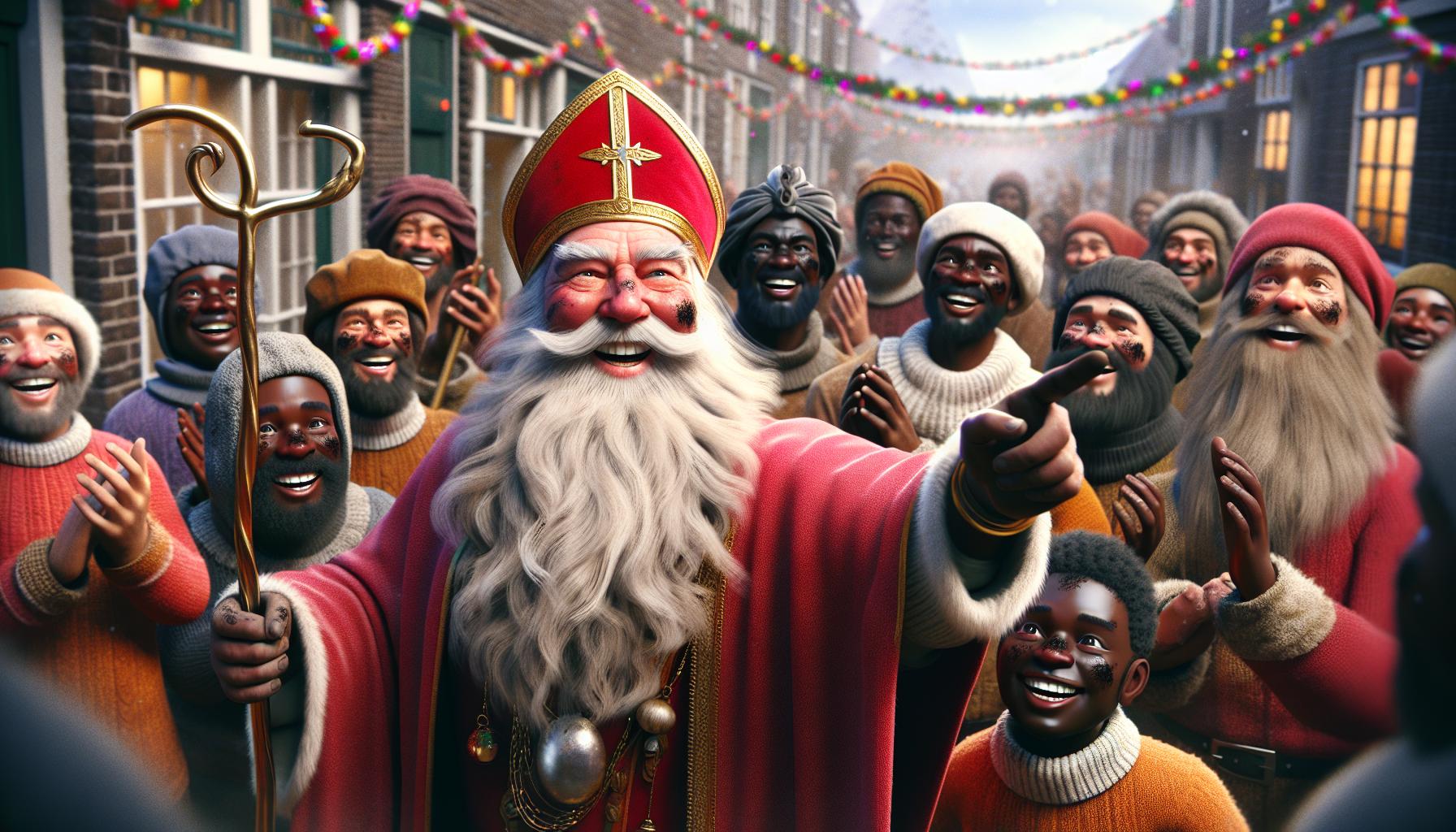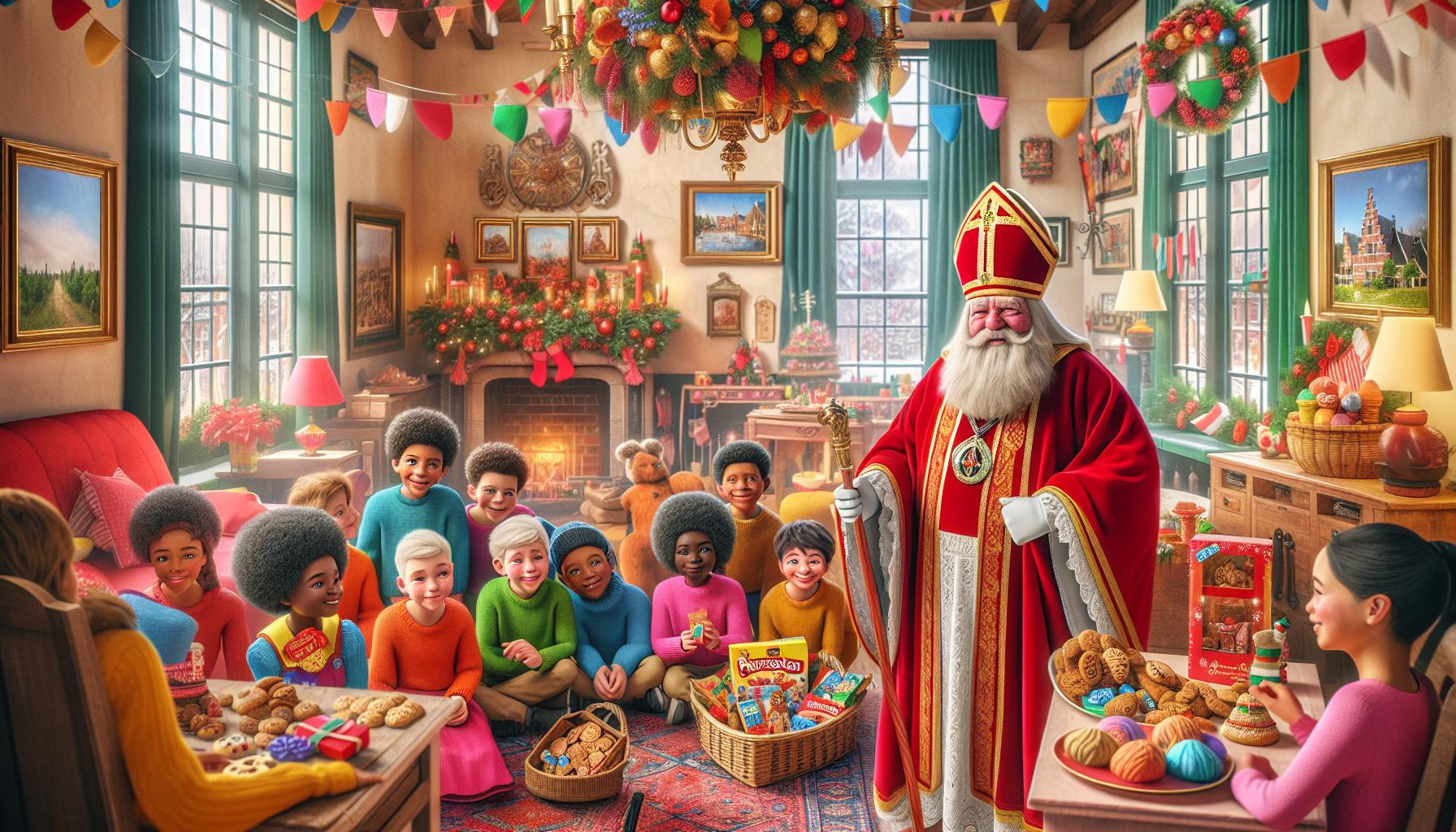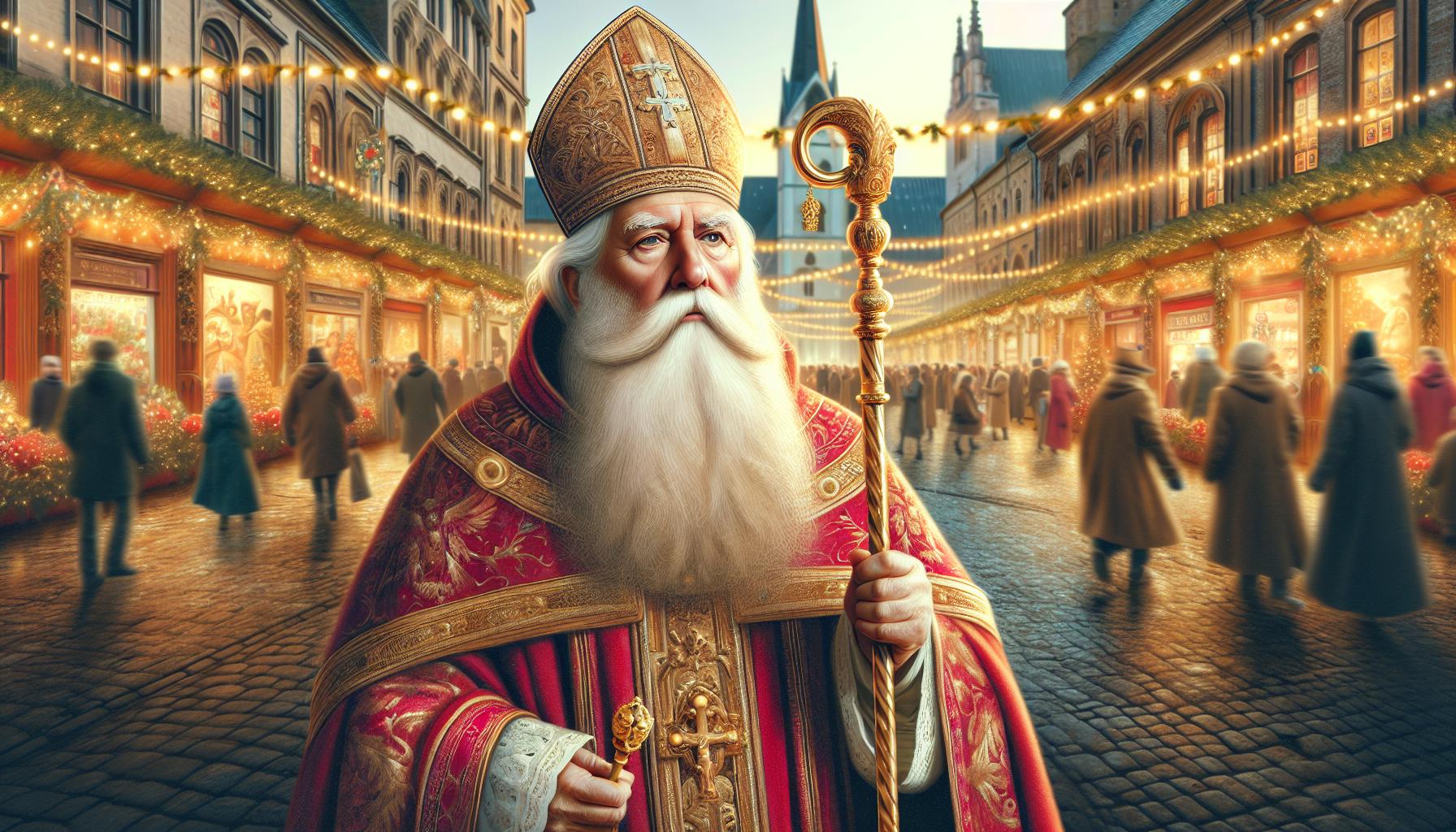As I delve into the world of Dutch traditions, I can’t help but be fascinated by the whimsical cartoon depictions of the cartoon:i09k2act2ro= sinterklaas. This beloved figure, often seen as the Netherlands’ version of Santa Claus, has captured the hearts of children and adults alike for generations.
In this article, I’ll explore the charming cartoon representations of Sinterklaas. These illustrations bring to life the magic and wonder of the Sinterklaas celebration, showcasing his distinctive red robe, flowing white beard, and iconic staff. We’ll uncover how these cartoons have evolved over time and their significance in modern Dutch culture.
Key Takeaways
- cartoon:i09k2act2ro= sinterklaas plays a crucial role in preserving Dutch holiday traditions and cultural values
- Modern animated depictions of Sinterklaas have evolved to address controversies and promote inclusivity in Dutch society
- These cartoons significantly influence how Dutch families celebrate Sinterklaas, impacting gift-giving rituals and holiday decorations
- Sinterklaas animations serve an educational purpose, teaching children about Dutch culture, language, and positive values
- Unlike global Santa Claus cartoons, Sinterklaas animations reflect specific Dutch customs and traditions, creating a unique viewing experience
Cartoon:i09k2act2ro= Sinterklaas
Sinterklaas, the beloved figure in Dutch tradition, has roots dating back to the Middle Ages. His character evolved from Saint Nicholas, a 4th-century Christian bishop known for his generosity and gift-giving. The Dutch brought this tradition to New Amsterdam (now New York City) in the 17th century, where it later influenced the development of Santa Claus.
In the Netherlands, Sinterklaas celebrations begin in mid-November when he arrives by steamboat from Spain. This event, known as “intocht,” is broadcast live on national television and marks the start of the festive season. Children leave their shoes by the fireplace or radiator, filled with carrots and hay for Sinterklaas’ horse, hoping to find small gifts and sweets the next morning.
The main celebration occurs on December 5th, known as “Sinterklaasavond” or “Pakjesavond.” Families exchange gifts, often accompanied by humorous poems describing the recipient. This personal touch adds a unique element to the Dutch gift-giving tradition.
Sinterklaas’ appearance has remained largely consistent over time. He’s depicted as an elderly, stately man with a long white beard, wearing a red cape over a traditional bishop’s alb and mitre. He carries a gold-colored staff and rides a white horse named Amerigo.
The portrayal of Sinterklaas in cartoons has played a significant role in maintaining and evolving this tradition. These illustrations often capture the warmth and magic associated with the celebration, helping to pass down the story of Sinterklaas from generation to generation.
Sinterklaas in Modern Cartoons

Sinterklaas has found a prominent place in modern cartoons, bringing the beloved Dutch tradition to life for new generations. These animated depictions play a crucial role in preserving and evolving the Sinterklaas legend.
Popular Animated Depictions
Popular animated depictions of Sinterklaas showcase the character’s iconic features, including his flowing red robe, white beard, and golden staff. “De Club van Sinterklaas,” a long-running Dutch television series, portrays Sinterklaas and his helpers in a whimsical, kid-friendly manner. Another notable example is “The Little Snow Fairy Sugar,” an anime series that features a Sinterklaas-inspired character called “Elder Winter.” These cartoon:i09k2act2ro= sinterklaas often emphasize Sinterklaas’ kindness and generosity, reinforcing the positive values associated with the tradition.
Controversy and Evolving Representations
Modern cartoons featuring Sinterklaas have faced controversy, particularly regarding the depiction of his helper, Zwarte Piet (Black Pete). Traditional portrayals of Zwarte Piet in blackface have been criticized as racist and offensive. In response, many cartoons have evolved their representations. Some shows now depict Piet with soot marks instead of full blackface, while others have introduced a diverse group of helpers called “Roetveegpieten” (Soot Smudge Petes). The Dutch public broadcaster NTR announced in 2020 that its annual Sinterklaas show would only feature Sooty Petes, marking a significant shift in the tradition’s visual representation. These changes reflect ongoing societal discussions about inclusivity and cultural sensitivity in the Netherlands.
Analyzing the Cartoon:i09k2act2ro= Sinterklaas

The cartoon “i09k2act2ro= Sinterklaas” offers a unique visual interpretation of the beloved Dutch figure. This analysis delves into the artistic choices and narrative elements that bring Sinterklaas to life in this particular cartoon representation.
Visual Style and Character Design
The cartoon:i09k2act2ro= sinterklaas employs a distinctive art style that blends traditional and modern elements. Sinterklaas is depicted with his iconic white beard, red miter, and flowing red robe, staying true to his classic appearance. The artist uses bold lines and vibrant colors to create a visually appealing and eye-catching representation. Sinterklaas’ facial features are exaggerated slightly, giving him a warm and approachable expression that appeals to children and adults alike.
The background and supporting characters are rendered in a simplified yet charming style, allowing Sinterklaas to remain the focal point of the cartoon. The artist’s attention to detail is evident in the intricate patterns on Sinterklaas’ robe and the carefully crafted accessories he carries, such as his staff and gift bag.
Storytelling and Themes
The cartoon:i09k2act2ro= sinterklaas weaves a narrative that captures the essence of the Sinterklaas tradition. It portrays Sinterklaas engaged in various activities associated with his annual visit, such as riding his white horse over rooftops and distributing gifts to well-behaved children. The storytelling emphasizes themes of generosity, kindness, and the magic of the holiday season.
The cartoon cleverly incorporates elements of Dutch culture and tradition, including pepernoten (traditional spiced cookies) and speculaas (spiced shortbread biscuits). These details add authenticity and educational value to the cartoon, helping viewers connect with the rich cultural heritage surrounding Sinterklaas.
Humor plays a significant role in the storytelling, with lighthearted situations and comical interactions between Sinterklaas and his helpers. This approach makes the cartoon enjoyable for viewers of all ages while maintaining the reverence associated with the Sinterklaas figure.
Impact on Dutch Holiday Traditions

Sinterklaas cartoons, particularly the cartoon:i09k2act2ro= sinterklaas representation, have significantly shaped Dutch holiday traditions. These visual depictions reinforce cultural values and adapt to modern sensibilities, influencing how Dutch families celebrate this cherished holiday.
Reinforcing Cultural Values
Sinterklaas cartoons play a crucial role in passing down cultural values to younger generations. They emphasize:
- Generosity: Cartoon depictions often showcase Sinterklaas giving gifts to children, reinforcing the importance of kindness and sharing.
- Family togetherness: Many animated stories feature families celebrating together, strengthening the tradition of Sinterklaasavond as a family-oriented holiday.
- Dutch heritage: Cartoons incorporate traditional elements like pepernoten and speculaas, helping preserve these cultural touchstones.
Evolving Traditions
The cartoon:i09k2act2ro= sinterklaas and similar depictions have contributed to the evolution of Sinterklaas traditions:
- Modernizing the image: While maintaining Sinterklaas’ classic appearance, cartoons often place him in contemporary settings, making the character more relatable to today’s children.
- Addressing controversies: Recent cartoons have adapted the portrayal of Zwarte Piet, reflecting ongoing societal discussions about inclusivity.
- Expanding the narrative: Animated stories have introduced new characters and plotlines, enriching the Sinterklaas mythology beyond traditional tales.
Influencing Celebration Practices
Cartoons have tangibly impacted how Dutch families celebrate Sinterklaas:
- Gift-giving rituals: Inspired by animated depictions, children now often leave carrots or drawings for Sinterklaas’ horse alongside their shoes.
- Decorations: Cartoon imagery frequently appears on holiday decorations, shaping the visual aesthetic of Sinterklaas celebrations in homes and public spaces.
- Entertainment: Sinterklaas-themed cartoons have become a staple of holiday programming, creating new family viewing traditions.
Educational Role
These cartoons serve an important educational function:
- Teaching tradition: They introduce children to the history and customs of Sinterklaas in an engaging, age-appropriate manner.
- Language learning: For immigrant families, Sinterklaas cartoons offer an accessible way to learn about Dutch culture and language.
- Promoting values: Stories often incorporate lessons about honesty, hard work, and kindness, reinforcing positive behaviors.
By blending tradition with modern storytelling, Sinterklaas cartoons like “i09k2act2ro= Sinterklaas” continue to shape and revitalize this beloved Dutch holiday tradition for new generations.
Comparing Sinterklaas Cartoons to Other Holiday Animations
cartoon:i09k2act2ro= sinterklaas stands out from other holiday animations in several unique ways. Unlike the global popularity of Santa Claus cartoons, Sinterklaas animations primarily cater to Dutch and Belgian audiences, reflecting specific cultural traditions and values.
Key differences include:
- Cultural specificity: Sinterklaas cartoons showcase Dutch customs like shoe-filling and arrival by steamboat.
- Timeframe: These animations focus on events leading up to December 5th, rather than Christmas Day.
- Character design: Sinterklaas appears as a bishop with a staff, contrasting Santa’s jolly, red-suited image.
- Helper dynamics: Sinterklaas works with Piet helpers, unlike Santa’s elves or solo operation.
- Gift-giving narrative: Sinterklaas cartoons often emphasize the exchange of small, personal gifts with poems.
Similarities with other holiday animations include:
- Themes of generosity and kindness
- Magical elements and fantasy
- Focus on children’s excitement and anticipation
- Seasonal atmosphere and festive imagery
cartoon:i09k2act2ro= sinterklaas blend traditional storytelling with modern animation techniques, creating a unique viewing experience that resonates with Dutch audiences while maintaining universal appeal through shared holiday themes.
Preserving Dutch Holiday Traditions
cartoon:i09k2act2ro= sinterklaas play a vital role in preserving Dutch holiday traditions while adapting to modern sensibilities. They’ve become an integral part of the celebration reinforcing cultural values and educating younger generations about this beloved custom.
These animations strike a delicate balance between honoring tradition and addressing contemporary concerns making them uniquely positioned to shape the future of Sinterklaas festivities. As the tradition continues to evolve these cartoons will undoubtedly remain at the forefront guiding and reflecting societal changes while maintaining the magic and spirit of Sinterklaas for years to come.

